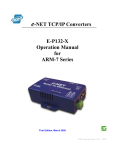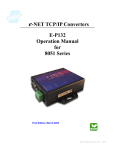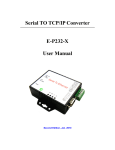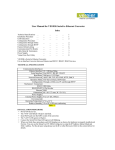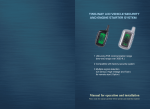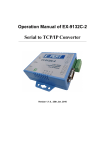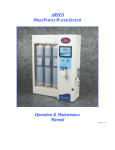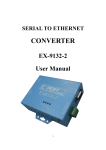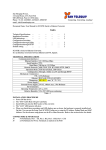Download E-P132-100 Manual - A
Transcript
Serial To Ethernet Converter E-P132-100 User Manual 1 Table of Contents Introduction ……………………………………………....………………………4 Overview ………………………………………………………………………….. 5 ……………………………………………………………… 6 Package Checklist Block Diagram ……………………………………………………………………7 Product Features ………………………………………………………………...8 Product Specifications ………………………………………………………… 9 Converter Description & Installation …………………………………11 Product Panel Views Left Side Right Side …………………………………………………………...11 …………………………………………………………………………. 12 ……………………………………………………………………….. 13 LED Indicators …………………………………………………………………..1 4 Wiring Architecture …………………………………………………………… 15 RS-232 …………………………………………………………......................... 15 RS-422/RS-485 …………………………………………………………………..16 Converter Configuration …………………………………………………..17 Initial IP Configuration ….………………………………….…………………….17 Device Management Utility of ETM….…………………………………………18 Menu “View”……………………………………………………………………….19 2 Menu “Config” …………………………………………………………………19 Web Console Configuration …………………………………………………19 Controller Status ………………………………………………………………22 Controller Setup ……………………………………………………………….24 Controller Updated ……………………………………………………………30 Factory Default Setting Self-Testing ……………………………………………………….31 …………………………………………………………………..32 Hyper Terminal for TCP/IP WinSock Hyper Terminal for COM Port Data Transmission …………………………………………33 ……………………………………………….36 …………………………………………………………….36 Appendix A - FAQ …………………………………………………………37 Appendix B - Pin Outs and Cable Wiring DC Power Outlet ………………………..38 ……………………………………………………………….38 RJ-45 Pin Assignment ………………………………………………………..38 RS-232 Pin Assignment ……………………………………………………...38 RS-422 Pin Assignment ……………………………………………………...39 RS-485 Pin Assignment ……………………………………………………...39 3 Introduction We are providing new ways of connecting serial devices to Local Area Network (LAN) or Wide Area Network (WAN). E-P132-100 TCP/IP converter designed to operate serial ports over 10/100M Ethernet networks. The data transmitted via TCP/IP protocol. Therefore control is available via Ethernet, Intranet and Internet. E-P132-100 TCP/IP converter packaged in plastic case well suited for industrial environments. All serial ports operate in common RS-232 mode, industrial RS-422 and RS-485 modes configuration. E-P132-100 TCP/IP converter series is low-cost, high performance design. By careful selecting high quality with competitive prices components in the world, E-P132-100 makes network connectivity possible with affordable cost for virtually all kinds of serial devices. The following topics are covered in this chapter: ◎ ◎ Overview ◎ ◎ Package Checklist ◎ ◎ Block Diagram ◎ ◎ Product Features ◎ ◎ Product Specifications 4 Overview E-P132-100 TCP/IP converter designed to make your serial devices Internet ready instantly. 8051 Series of E-P132-100 TCP/IP converter makes ideal choice for connecting your RS-232 or RS-422/485 serial devices—such as PLCs, meters and sensors—to IP-based Ethernet LAN, making possible for your software to access serial devices anywhere and anytime over local LAN or the Internet. 8051 Series converters ensure the compatibility of network software that uses standard network API (Winsock or BSD Sockets) by providing TCP Server Mode, TCP Client Mode, and UDP Mode. 8051 Series’ Virtual COM driver, software that works with COM port can be set up to work over TCP/IP network in no time. This excellent feature preserves your software investment and let you enjoy the benefits of networking your serial devices instantly. 8051 Series converters support manual configuration via the handy web browser console and many protocols including TCP, IP, UDP, HTTP, DHCP, ICMP, and ARP. They are the best solution to network your serial devices. 5 Package Checklist 8051 products are shipped with the following items: □□ 1 unit of E-P132-100 TCP/IP converter □□ 1 unit of Power Adaptor ( Input :120VAC 60Hz 200mA ) (Output :9VDC 500mA ) □□ Documentation & Software CD NOTE: Notify your sales representative if any of the above items are missing or damaged. 6 Block Diagram Low-cost devices usually are equipped with low speed processors and limited memories. In reality, they are neither having the capability nor practicality to manage complicated network TCP/IP protocols. 8051 Series is low cost while providing high performance network solution by converting data stream between network TCP/IP and popular serial port signals. In stead of processing TCP/IP packets directly, devices need only deal with those interface signals, which greatly simplifies the complexity of TCP/IP network in linkage. 7 Product Features □□ Data Conversion between RS-232/422/485 and Ethernet Convert serial device (RS-232, RS-422, RS-485) data/signal into the TCP/IP packet data/signal and send them out with the Ethernet data stream or convert the TCP/IP packet data/signal into serial device data/signal. □□ Dynamic IP Configuration Support DHCP client mode, simplifying network address configuration and management. □□ Dual LAN Speed Support 10/100 Mbps Ethernet, auto-detected. □□ Server / Client Dual Modes 8051 Series can be configured as network server or network client. In the client mode, it can be installed network which protected by NAT router or firewall, without need of real IP address. □□ Web-based Setup Parameters setup based on HTTP protocol by using standard browsers (IE and Netscape). No special software would be required. □□ Built-in Security Control Protected setup the password to prevent intruders. □□ Firmware Remote Update Firmware can be updated directly via Ethernet network to keep up with latest network standards. 8 Product Specifications l CPU : 8-bits 8051 , 36.864 MHz l RAM : 32K Bytes SRAM l ROM : 64 K Bytes l Ethernet ● Port Type : RJ-45 Connector ● Speed : 10 /100 M bps ( Auto Detecting ) ● Protocol : ARP, IP, ICMP, UDP, TCP, HTTP, DHCP ● Mode : TCP Server ,TCP Client , UDP ● Setup : HTTP Browser Setup (IE & Netscape), RS-232 Console ● Security : Setup Password ● Protection : Built-in 1.5KV Magnetic Isolation l Serial Port ● No. of Ports : RS-232 / RS-422/RS-485 x 1 Port ● Port Type : DB9 male ● Speed : 300 bps〜115.2k bps ● Parity : None , Odd , Even ● Data Bit : 7 , 8 ● Stop Bit : 1 , 2 ● RS-232 Signals : Rx , Tx , GND , RTS , CTS , DTR , DSR , DCD ● RS-422 Signals : Rx+ , Rx- , Tx+ , Tx- (Surge Protection) 9 ● RS-485 Signals : Data+ , Data- (Surge Protection) ● Built-in RS422/RS485 Terminal Resistor l 15KV ESD for all signal l Watch Dog Function l Firmware On-line Updated Via Ethernet l Power : Input : DC 9 – 12 V l LED Lamp : PWR (Green) l DATA (Red-Blink during data transferring and receiving) l LAN (Red) l SYS (Red-Blink) l Environment : Operating Temperature : 0℃〜60℃ Storage Temperature : -10℃〜70℃ l Dimensions : 85 x 75 x 25 mm ( W x D x H ) l WEIGHT : 110 gm l RoHS :Compliant with RoHS l Regulatory Approvals : EMC : FCC Class A, CE Class A l WARRANTY : 1 year 10 Converter Description Product Panel Views Terminator DC-In Power Outlet Serial Port RS-485/RS-422 LAN Serial Port RS-232 Reset Button LED Indicators LED Indicators 11 Left Side Power Supply The E-P132-100 TCP/IP converter powered by single 9~12V DC(Inner positive/outer negative) power supply and 500mA of current. A suitable power supply adapter part of the packaging. Connect power line to power outlet at right side of E-P132-100 TCP/IP converter and put the adapter into socket. If the power properly supplied the “PWR” green color LED will blink each time in one second. DC-In Power Outlet LAN Reset Button LAN Port The connector for network is usual RJ45. Simply connect to your network switch or Hub. When the connection made, the LAN LED indicator will light. When data traffic occurs on the network, red DATA LED indicator will blink during data transferring and receiving. Reset Button Press button then turn on the power and waiting for 3 seconds. Converter will reset to factory default. 12 Right Side Terminator Serial Port RS-485/RS-422 Serial Port RS-232 Serial I/O Port of RS-232/RS-422/RS-485 Connect the serial data cable between converter and serial device. Follow the parameter setup procedures to configure the converter (see the following chapters). Terminator There is terminator resistor built in. If switch 1 & 2 are set in “ON” position, 120 Ohm resistor connected between the signals. 13 LED Indicators SYS “Red LED” : Power indicator (When power on, LED will flash each time in one second.) LAN “Green LED” : On-line indicated (When converter is link to LAN then LED will keep on.) 100M- Green LED、10M- Red LED DATA “Red LED” : Data sending & receiving indicator (When data is sending and receiving to network, LED will blink.) PWR “Red LED” : Power indicator (When power on, LED will light all the time.) 14 Wiring Architecture RS-232 Wiring Architecture 15 RS-422 / RS-485 Wiring Architecture When you finish the steps mentioned above and LED indicators as shown, installed converter correctly. You can use Setup Tool “ETM.exe” to setup the IP Address. For proceed the advanced parameters setup, please use web browser (IE or Netscape) to continue the setting detailed. 16 Converter Configuration Initial IP Configuration When setting up your converter for first time, the first thing you should do is configure the IP address. This chapter introduces the method to configure the device server’s IP address. For more details about network settings, see “Web Console Configuration” (In the next sub section). For quickly and easier to start, we suggest you to reference “Quick Installation Guide” manual. The following topics are covered in this chapter: □□ Device Management Utility □□ Menu “View” □□ Menu “Config” 17 Device Management Utility of ETM On PC we provide Device Management Utility named ETM.exe which is executable program in Windows 32 bit environments. ETM Setup Tool used to detect and setup the installed converters. It uses UDP broadcast packets to query and configure converters on the network. When you activate tool, it will detect existence of the installed converters and depict the converters’ status such as IP address, Subnet Mask, MAC Address and Device ID (see Figure 3.1). If your computer OS is Windows XP version which means “WINDOWS Firewall” function in OS activated. However ETM.exe wouldn’t detect the converter’s IP address, therefore you have to temperately disable “WINDOWS Firewall” function. After finishing the parameters settings, you can restart “WINDOWS Firewall” function. Due to the nature of broadcast UDP packets, ETM has following characteristics: □□ Broadcast packets aren’t limited by subnet. Even if IP address of the converters and computer running ETM do not belong to the same subnet, it still works fine. □□ Broadcast packets can not pass routers. ETM can only used to monitor devices with computer running ETM in the same segment of local area network. (Figure 3.1) 18 Menu “View” □□ View -> Refresh F5 Refresh the status. ETM will send another query to get updated information (see the Figure 3.2). Note: Always run the “View-> Refresh” after any data change. (Figure 3.2) ( (Figure 3.2) View -> Exit Alt+F4 Exit from the program (see Figure 3.2). Menu “Config” Config -> IP Address (see Figure3.3) (Figure 3.3) (Figure3.3) 19 Press ENTER or select [IP Address] in the [Config] menu, dialog will be shown (see Figure 3.4). Note: Because ETM uses broadcast UDP packets, for sake of security, it allows configuration only when device's setup password is empty. (Figure 3.4) (Figure 3.4) Assign IP Address with the same Subnet Mask of your computer, avoiding any IP conflict with other network devices. When you press [Ok] button, the IP address will be refreshed in 2~3 seconds (see the Figure 3.5). (Figure 3.5) 20 Web Console Configuration In addition to basic IP address and subnet mask, specific device setting can be set through HTTP protocol with popular browsers, e.g. Internet Explorer, Netscape, etc. Setup the converter as easy as surfing on WWW, no special software will be required. Press [Alt] + [Enter] or select [Device Settings] in [Config] menu, it will open a new window in browser to login into the device. Alternatively, if IP address of converter already known, you can connect to converter directly by providing its IP address in URL field of browser. The following topics are covered in this chapter: ◎ ◎Controller Status ● Login Page ● Field Description ◎ ◎Controller Setup ● Setup Page ● Field Description ◎ ◎Controller Updated ◎ ◎Factory Default Setting 21 Controller Status The Login Page Setup the E-P132-100 TCP/IP converter as easy as surfing on WWW, no special software will be required. Popular Browsers, such as IE or Netscape, can easily do the setup process. In the browser URL field, set the IP address of device directly, to enter the “Controller Status” page, please follow the steps below. □□ Open your browser. This chapter will use IE as example. □□ In the browser URL field, type IP address of converter directly and press ENTER. (The IP address is what you set using the Device Management Utility.) □□ The “Controller Status” page will be shown (see Figure 3.6). (Figure 3.6) 22 Field Description □□ System time elapsed The time elapsed since start of this device in [Day Hour: Minute: Second] format. This information can be useful identifying the reliability of system. □□ Firmware version Converter firmware identified by date code. This information will be required in looking for technical support. □□ Serial number Converter consisted “Type Number (5 digits) and the unique MAC (Media Access Control) address used by Ethernet in hex format 8 digits. □□ Password (Setup Login) This field is administration password for authentication. Factory is default “empty”. However, it is not recommended to leave it empty in field operation. If you could not login, it means you have to key the password. If you do not know the password you can turn off the power and then use any tip point to press “Reset” button and hold it and turn on the power. The password will be reset to the factory default as “empty”. E-P132-100 TCP/IP converter uses the same password protection mechanism commonly used in Windows NT or UNIX. If there are more than “3 consecutive failures” in the password check during login, the login function will be disabled for “15 minutes”. During this 15 minutes period, if you supply correct password, login will not proceed. This prevent intruder from finding the password by computer generated program. 23 Controller Setup □□ The Setup Page Type the correct password in the “Password” field and click [Login] button in the “Controller Status” page, then the “Controller Setup” page will appear (see the Figure 3.7). Note: If you forget the password or can’t login successfully, please contact the manufacturer directly. (Figure 3.7) 24 □□ Field Description □□ IP Address The IP address of E-P132-100 TCP/IP converter, 4 digits by separated do not let conflict with other devices on the network. If DHCP client mode enabled and there's DHCP server on the network, this field will be assigned by DHCP server automatically. □□ Subnet mask Subnet mask of the network E-P132-100 TCP/IP converter has connected to. “255.255.255.0” usually used for small network, “255.255.0.0” for larger network, separated by 4 digits'.' If your IP address provides by ISP or internal network administrator, please inquire of their information and type it correctly. If DHCP client mode enabled and there's DHCP server on the network, this field will be assigned by DHCP server automatically. □□ Gateway address Gateway or Router IP address. 'Gateway' is device which connects local network to external network. If you need to communicate with other networks or your device owns a real IP address on the internet, please inquire of their information and type it correctly. If there's no gateway on the network, just leave it as “0.0.0.0”. If DHCP client mode enabled and there's DHCP server on the network, this field will be assigned by DHCP server automatically. 25 □□ Network link speed The Physical Ethernet of speed links. “Auto” means the speed automatically selected by the converter. You can also specify “10Mbps” or “100Mbps” to match the speed of the HUB. □□ DHCP client DHCP client mode could be enabled/disabled statues. If DHCP enabled, there should be DHCP server on the network. If DHCP disabled, [IP address], [Subnet mask], and [Gateway address] should be manually assigned. □□ Socket port of HTTP setup The socket port used to setup conduct the browser. Normally, HTTP protocol use TCP port “80” for communication. If the field changed to “81”, the port “80” will be reserved for user's own Web. To enter the browser setup page, “http://x.x.x.x: 81” should be typed for socket port “81” and “http://x.x.x.x” for socket port “80”, where “x.x.x.x.” is converter’s IP address.. □□ Socket port of serial I/O Port number A socket port assigned for serial port. It’s 16-bit number, ranging from 1 to 65535. Because the number below 1000 used for specific purposes (e.g. 80 for HTTP protocol), we suggest you use the number larger than 1000. Generally the port number 4660 is used for the serial communication. However you should specify different port number for each serial port. Socket type 26 TCP Server: Protocol TCP, open the passive, to be connected from the TCP clients. TCP Client: Protocol TCP, open the active, connect to the TCP server. UDP: Protocol UDP, connectionless □□ Socket port of digital I/O Port number A socket port assigned for the serial port. It’s 16-bit number, ranging from 1 to 65535. Because the numbers below 1000 are used for specific purposes (e.g. 80 is for HTTP protocol), we suggest you use the number larger than 1000. Generally the port number 4660 is used for the serial communication. However you should specify different port number for each serial port. Socket type TCP Server: Protocol TCP, open the passive, to be connected from the TCP clients. TCP Client: Protocol TCP, open the active, connect to the TCP server. UDP: Protocol UDP, connectionless □□ Destination IP address The server IP address and socket port would be connected in TCP Client and UDP mode for IP address of certain server. □□ Destination socket port The server socket port would be connected in TCP Client and UDP mode for a certain socket port. □□ Connection The connection can be selected in 2 modes. “Auto function for connect Automatic of converter” “Manual function for program control of converter” □□ TCP socket inactive timeout ( minutes ) 27 We add mechanism - "inactive timeout" to identify whether the socket active or dead. If there is no any data transferred (send / receive) within the timeout defined period (1 to 99 minutes), then it is probably a dead socket and the socket will be closed automatically, thus a new connection can be accepted again. The timeout period can be set by user to fit different kinds of application. □□ Serial I/O setting baud rate , parity , data bits , stop bits Baud Rate: 300 ~ 115200 bps Parity: None, Even, Odd Data Bits: 7, 8 Stop Bit: 1 or 2 □□ Interface of serial I/O RS232: TxD, RxD for data stream, no flow control RS232 (RTS/CTS): TxD, RxD for data stream, RTS/CTS to control the flow. RS232 (RTS/CTS, DTR/DSR): TxD, RxD for data stream, RTS/CTS to control the flow. For DTR status socket, DSR socket to control open/close. RS485 (Half duplex): Half duplex RS-485 interface RS422 (Full duplex): Full duplex RS-422 interface □□ Packet mode of serial input Packet mode could be enabled/disabled mode. If packet mode enabled, the data input from UART will be deferred until the input buffer is full or the converter detect 10-character packet gap and no more character will arrived. The block waiting time extended to avoid the splitting of the complete packet. □□ Device ID User assigned ID number for the converter. Available ID is “0 ~ 65535”. 28 □□ Report device ID when connected In TCP mode, if this parameter enabled, every time when the socket connected, E-P132-100 TCP/IP converter will immediately report its device ID in the following formats: Serial #1 nnnnnA[LF][CR] Serial #2 nnnnnB[LF][CR] Digital I/O nnnnnC[LF][CR] The total length is 8 bytes, assigned ID where “nnnnn” for the 5-digit device by the user; [LF] is decimal 10; [CR] is decimal 13. □□ Setup password Administration password used to login the “Controller Setup” page. It may be empty or long up to 15 characters. 29 Controller Updated Press “Update” Button After you finish the detailed parameter setting. The converter will save all parameters into internal non-volatile memory and then reboot (see Figure 3.8). It takes about 5 seconds to complete the whole process and a new login page will be presented (see Figure 3.1). You can re-login and check if all parameters have been correctly saved. If everything ok, you can close the browser now. Note: If domain of the converter different running the browser from that computer, the login page won’t appear unless the converter’s “Gateway Address” has been correctly set. (Figure 3.8) 30 Factory Default Setting If by the chance, you forget the setup password or have incorrect setting making the converter inoperable, there are two ways to reset the setting and the following procedures can be used to reset all settings to factory default: A: 1. Turn off the power of converter. 2. Press the reset button of converter. 3. Turn on the power of converter and wait for 3 seconds. 4. The password will reset to the factory default (empty). B: 1. Log in the web page. 2. Press the reset button of converter. 3. Select the update button. 4. After Tx & Rx light flashing then unclasp the reset button. 5. The password will reset to the factory default (empty). 31 Self-Testing After completing the wiring and parameter setting, we should verify if setting correct or not. This chapter will introduce how to use a single computer to test if the converter behaves well. The operating system can be Windows 95, 98, ME, XP, 2000. The “Hyper Terminal” utility should be installed on your PC (see Figure 4.1). It can be found in your Windows installation CD. The wiring architecture similar to “RS-232 Wiring” in chapter 2 and “Serial Device” replaced by PC’s COM 1. The same PC also plays roll of Remote Host. The following topics are covered in this chapter: □□ Hyper Terminal for TCP/IP WinSock □□ Hyper Terminal for COM Port □□ Data Transmission 32 Hyper Terminal for TCP/IP WinSock Initiate Hyper Terminal from Start Menu in Windows (see Figure 4.1), give terminal name, choose an icon and press “OK” button (see Figure 4.2). (Figure 4.1) (Figure 4.2) Select “TCP/IP (Winsock)” option at “Connect using:” field (see Figure 4.3) 33 . (Figure 4.3) After “OK” button pressed, Figure 4.4 appears. Enter the converter’s IP address (e.g. 192.168.0.10) at “Host address:” field and Socket port number set for Serial Port 1 at “Port number:” field (e.g. 4660). (The Socket type of the Serial Port 1 should be “TCP Server”.) (Figure 4.4) 34 After pressed “OK” button, Figure 4.5 appears. If Hyper Terminal connects with converter successfully, the time clock at “left lower” corner “connect of hh:mm:ss” will start counting. (Figure 4.5) 35 Hyper Terminal for COM Port Initiate another Hyper Terminal as COM Port Terminal (in Figure 4.3, select COM 1 or other COM port instead of “TCP/IP (Winsock)”). To set the COM port Properties will be as same as Serial Port of converter. (Figure 4.3) Data Transmission When all steps described above are finished, type any characters on the COM Port Terminal and check if the typed characters are also displayed on the TCP/IP Winsock Terminal. Alternatively, check if the characters typed on the TCP/IP Winsock Terminal are also displayed on the COM Port Terminal. If yes, then all settings are correct and converter can operate properly. 36 Appendix A FAQ Q. Why can’t ETM.exe detect the converter on network? A. Please check 11.. Power properly plugged to the converter (Please refer “SYS’ LED). 22.. Network cable properly connected between the converter and Hub (Please 3. refer LAN LED). Close Windows or antivirus program firewall (Please refer Device Management Utility of ETM). Q. Why can’t I use IE to setup the converter? A. Please check if the network domain of PC is the same as converter. 37 Appendix B Pin outs and Cable Wiring □□ DC Power outlet □□ RJ-45 Pin Assignment □□ RS-232 Pin Assignment The pin assignment scheme for 9-pin male connector on DTE is given below. PIN 1 : DCD PIN 5 : GND PIN 9 : X PIN 2 : RXD PIN 6 : DSR PIN 3 : TXD PIN 7 : RTS □□ RS-422 Pin Assignment 38 PIN 4 : DTR PIN 8 : CTS The pin assignment scheme for 4-pin RS-422 is given below. 1 PIN 1 : T+ 2 3 4 PIN 2 : T- PIN 3 : R+ PIN 4 : R- □□ RS-485 Pin Assignment The pin assignment scheme for 4-pin RS-485 is given below. 1 PIN 1 : X 2 PIN 2 : X 3 4 PIN 3 : D+ PIN 4 : D- 39









































